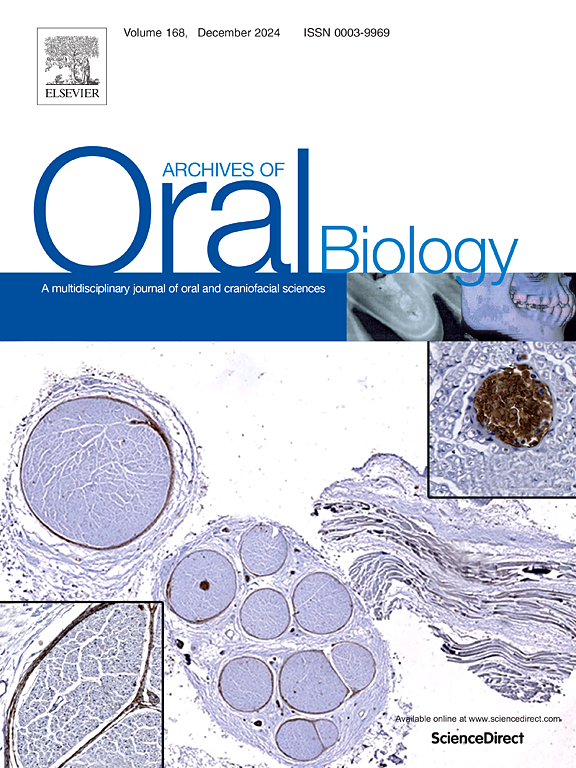十二烷基甲基氨基乙基甲基丙烯酸酯抑制白色念珠菌和粪肠球菌生物膜的生长和破骨细胞的形成
IF 2.1
4区 医学
Q2 DENTISTRY, ORAL SURGERY & MEDICINE
引用次数: 0
摘要
目的研究DMAEM对白色念珠菌和粪肠杆菌双菌种生物膜的抑菌作用及对破骨的抑制作用。采用DesignDMAEM单体,通过生物量定量、扫描电镜和共聚焦激光扫描显微镜扫描、RT-qPCR等方法评价其对白色念珠菌和粪肠杆菌双菌种生物膜的抑菌能力。采用生物量定量、Cell Counting kit-8、抗酒石酸酸性磷酸酶染色、流式细胞术分析、RT-qPCR等方法检测DMAEM根管封闭剂的生物安全性及对双物种生物膜和破骨作用的抑制能力。结果在8-256 μg/mL DMAEM作用下,白色念珠菌和粪肠杆菌形成的双种生物膜的生物量显著降低26.3-51.3 %。8 μg/mL DMAEM可使粪肠球菌存活率降至77.4% % (p <; 0.001),并下调其毒力基因表达。同时,双种生物膜中白色念珠菌菌丝计数比例从50 %降低到0 % (p <; 0.0001)。添加DMAEM的实验封口剂也能降低双种生物膜中白色念珠菌和粪芽孢杆菌的存活率。此外,含有≤ 2.5 % DMAEM的实验根管封闭剂的洗脱是生物安全的,与未修饰的根管封闭剂相比,至少提高了81.0 % (p <; 0.05)的破骨抑制作用。结论DMAEM对白色念珠菌和粪肠杆菌双菌种生物膜的抑菌作用和破骨抑制作用提示DMAEM在治疗根尖周炎症方面具有潜在的临床应用价值。本文章由计算机程序翻译,如有差异,请以英文原文为准。
Dodecylmethylaminoethyl methacrylate inhibits the growth of Candida albicans and Enterococcus faecalis biofilm and the formation of osteoclast
Objectives
This study aimed to evaluate the antimicrobial ability on the dual-species biofilm formed by C. albicans and E. faecalis and osteoclysis inhibition of DMAEM.
Design
DMAEM monomer was used to evaluate the antmicrobial ability on the dual-species biofilm of C. albicans and E. faecalis by biomass quantification, Scanning electron microscope and confocal laser scanning microscopy scanning, and RT-qPCR. The biosafty and inhibition ability on the dual-species biofilm and osteoclysis of the experimental root canal sealers containing DMAEM was tested by biomass quantification, Cell Counting kit-8, tartrate-resistant acid phosphatase staining, flow cytometry analysis, and RT-qPCR.
Results
The biomass of the dual-species biofilm formed by C. albicans and E. faecalis was significantly decreased by 26.3–51.3 % under 8–256 μg/mL DMAEM. 8 μg/mL DMAEM could reduce E. faecalis’s survival rate to 77.4 % (p < 0.001) and down-regulated its virulence gene expression. Meanwhile, the mycelium count proportion of C. albicans in the dual-species biofilm was reduced from 50 % to 0 % (p < 0.0001). The experimental sealers with DMAEM content could also decrease the survival rate of C.albicans and E.faecalis in the dual-species biofilm. Moreover, the elution of experimental root canal sealers containing ≤ 2.5 % DMAEM was biosafe and improved 81.0 % (p < 0.05) osteoclastic inhibition compared with it of unmodified sealers at least.
Conclusions
The antimicrobial ability on the dual-species biofilm formed by C. albicans and E. faecalis and osteoclastic inhibition of DMAEM suggested its potential clinical application of DMAEM in the treatment of periapical inflammation.
求助全文
通过发布文献求助,成功后即可免费获取论文全文。
去求助
来源期刊

Archives of oral biology
医学-牙科与口腔外科
CiteScore
5.10
自引率
3.30%
发文量
177
审稿时长
26 days
期刊介绍:
Archives of Oral Biology is an international journal which aims to publish papers of the highest scientific quality in the oral and craniofacial sciences. The journal is particularly interested in research which advances knowledge in the mechanisms of craniofacial development and disease, including:
Cell and molecular biology
Molecular genetics
Immunology
Pathogenesis
Cellular microbiology
Embryology
Syndromology
Forensic dentistry
 求助内容:
求助内容: 应助结果提醒方式:
应助结果提醒方式:


